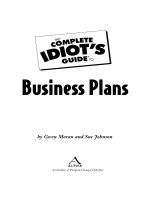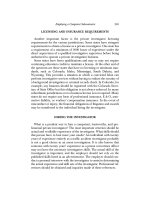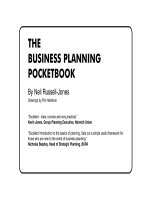Guide to Business Planning The Economist_1 potx
Bạn đang xem bản rút gọn của tài liệu. Xem và tải ngay bản đầy đủ của tài liệu tại đây (114.74 KB, 12 trang )
THE
BUSINESS PLANNING
POCKETBOOK
By Neil Russell-Jones
Drawings by Phil Hailstone
“Excellent - clear, concise and very practical.”
Kevin Jones, Group Planning Executive, Norwich Union
“Excellent introduction to the basics of planning. Sets out a simple useful framework for
those who are new to the world of business planning.”
Nicholas Beazley, Head of Strategic Planning, BUPA
Published by:
Management Pocketbooks Ltd
14 East Street, Alresford, Hants SO24 9EE, U.K.
Tel: +44 (0)1962 735573 Fax: +44 (0)1962 733637
E-mail:
Web: www.pocketbook.co.uk
All rights reserved
This edition published 1998. Reprinted 1999, 2000
© Neil Russell-Jones 1998
ISBN 1 870471 58 X
British Library Cataloguing-in-Publication Data – A catalogue record for this book
is available from the British Library.
Printed in U.K.
MANAGEMENT
POCKETBOOKS
CONTENTS
INTRODUCTION 1
Definitions, corporate & business
planning, visions, strategies
and plans
PLANNING THEORY 15
What is a plan, why plan, elements
of a plan, eight planning styles
PLANNING PROCESS 35
Seven stages of the planning
process
PRACTICAL PLANNING 69
Structuring, example company,
communicating, contingency
planning, organising to plan,
planning cycle, time charts,
critical path management, tips
SUMMARY 102
NB
1
INTRODUCTION
DEFINITION
Planning is a feature of everyday living - whether at home or in business.
Without it our lives would be totally chaotic and random.
Plans vary from imprecise vague statements to thick volumes prepared over a
long period.
Some are useful; others a waste of time. Very few remain unaltered.
People are frequently asked to prepare a plan with no guidance at all, and the
result often falls short of expectations.
2
INTRODUCTION
DEFINITION
Richard Hannay, the hero of many of John Buchan’s books, had a companion who was
a South African Boer - Peter Pienaar. Whenever he was faced with a seemingly
impossible situation he would say ‘Ik shall een plaan mak’ - I shall make a plan. He
would subsequently carry out the task successfully.
Planning is taking time to:
● Consider the possibilities that might arise as a result of something that you
wish to do
● Understand the consequences that arise, and
● Develop actions to counter them or to maximise opportunities
3
INTRODUCTION
WHO SHOULD USE THIS BOOK?
Planning takes place in all organisations in some form or other, whether it be formal or
informal, and at a variety of levels. Most planning is carried out by middle management
in larger organisations, and by people who run their own businesses (proprietors, sole
traders, partners or directors of small and medium sized organisations).
If you are in a department or business unit and have to prepare a plan, then this book
will help you understand the components and do’s and don’t’s of planning. Those
engaged in business on their own behalf will also find it useful.
Some parts of the book may be more appropriate to businesses than, for example, to
head office departments, but will fill out the wider background for the latter.
4
INTRODUCTION
WHO SHOULD USE THIS BOOK?
The Business Planning Pocketbook concentrates on what you need to do to produce a
plan. It includes both the theory and the practical aspects.
Whatever your situation, the basic planning process itself is fundamentally the same -
it is just the format and style of development, and sometimes execution, that differ.
There may be different front ends to the process, and different issues to consider, but
in essence plans are all the same: an indication of the expected future progress
of something.
There is also a body of people engaged in planning at a corporate level. (This is usually
termed corporate or strategic planning.) This book, whilst touching on strategic planning
by way of context, is not really for them.
5
INTRODUCTION
CORPORATE PLANNING
It is important to differentiate between planning that takes place at the highest level
and that which takes place within an organisation. The former may be referred to as
‘corporate planning’, and is usually found in large organisations; whilst the latter may
be referred to as ‘business planning’.
Corporate planning is concerned with planning for the organisation as a whole - not for
the whole organisation; and it is important to understand the difference.
Any organisation trying to plan for the whole will not succeed, due both to the workloads
and the immense number of variables for consideration. (A good analogy is with the
former Command Economies where they tried to plan entire countries centrally - with all
too familiar failures.)
Corporate planning is about deciding corporate goals and then developing corporate
strategies to achieve these. This might take several years and, therefore, it is by nature a
long-term view.
6
INTRODUCTION
BUSINESS PLANNING
Business planning is concerned with what is going to be done now to achieve
targets and goals.
It sits, therefore, at the tactical level rather than the strategic.
It is necessarily short-term in outlook; but can nevertheless span a number of years.
For example, building a ship or a petroleum cracking plant might take several years to
complete, but this would not be a corporate plan, merely one component of a business
plan (although for some firms it might be a very large component).
Generally, business plans take a one year horizon, although they will sit within the
long-term framework established at a corporate level.
7
INTRODUCTION
VISIONS, STRATEGIES & PLANS
It is important to understand the difference between a vision,
a strategy and a plan. People often use the terms interchangeably
which leads to confusion. In a business sense, however:
8
● A vision is the long-term view or ideal that
drives the organisation
● The strategy is the articulation of the vision into
practical reality, given the actual situation
● The plan is the tactical means of achieving the
strategy - the actions that need to be taken









